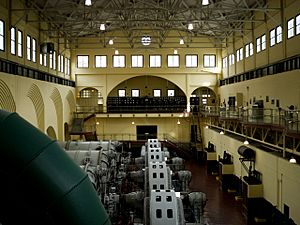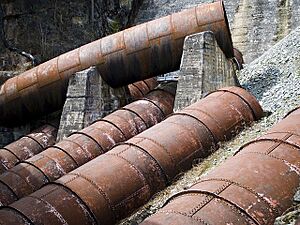Stave Falls Dam and Powerhouse facts for kids
Quick facts for kids Stave Falls Dam |
|
|---|---|

Interior of the original Stave Falls power house
|
|
|
Location of dam in British Columbia, Canada
|
|
| Country | Canada |
| Location | Stave Falls |
| Coordinates | 49°13′47″N 122°21′20″W / 49.22972°N 122.35556°W |
| Status | Operational |
| Construction began | 1909 |
| Opening date | 1912 |
| Owner(s) | BC Hydro |
| Dam and spillways | |
| Impounds | Stave River |
| Length | 122 m (400 ft) Blind Slough Dam: 190 m (623 ft) |
| Elevation at crest | 83.75 m (275 ft) |
| Width (crest) | 5 m (16 ft) Blind Slough Dam: 8.5 m (28 ft) |
| Spillways | 2 |
| Spillway type | Sluice/Tainter gate controlled |
| Spillway capacity | 3,500 m3/s (123,601 cu ft/s) |
| Reservoir | |
| Creates | Stave Lake |
| Total capacity | 470,000,000 m3 (381,035 acre⋅ft) |
| Catchment area | 1,170 km2 (452 sq mi) |
| Surface area | 62 km2 (24 sq mi) |
| Normal elevation | 82 m (269 ft) |
| Power station | |
| Operator(s) | BC Hydro |
| Commission date | Original: 1911 New: 2000 |
| Turbines | 2 x 45 MW Kaplan turbines |
| Installed capacity | 90 MW |
| Annual generation | 362 GWh |
| Official name: Stave Falls Hydro-Electric Installation National Historic Site of Canada | |
| Designated: | 2003 |
The Stave Falls Dam is a special power station with two dams on the Stave River in Stave Falls, British Columbia, Canada. It was finished in 1912 to make hydroelectric power, which is electricity from moving water. To hold more water in Stave Lake, the dam was made taller in 1925. The Blind Slough Dam was also built about 500 m (1,600 ft) north of the main dam, right where the original Stave Falls used to be.
In 2000, the old power plant at the dam was replaced with a new one after a four-year upgrade. The first Stave Falls power plant was once the biggest source of hydroelectric power in British Columbia. Today, it is recognized as a National Historic Site of Canada.
Contents
How the Dam Started
The idea for the Stave Falls Dam first came up in the 1890s. This was a time when making electricity from water power was becoming very popular. People saw that the 24 m (79 ft) drop of Stave Falls could be used to create a lot of electricity. This power could then be sold to different towns and businesses.
In 1895, a company called Stave Lake Electric and Power Co. Ltd got permission to study the falls for making electricity. Later, in 1909, the Western Canada Power Company bought Stave Lake Electric and Power. They then started building the dam.
The first machine that made electricity, called a generator, started working in December 1911. A second one began in January 1912. More generators were added over the years: the third in 1916 and the fourth in 1922.
In 1921, another company, British Columbia Electric Railway, bought Western Canada Power. They kept working on the power plant. A fifth generator was added because they realized they could make even more power. This was possible by raising the dam and adding water from a new lake created by the Alouette Dam. The Stave Falls Dam was made taller in 1925, and the fifth generator started on September 19, 1925.
In 1926, the Blind Slough Dam was finished. It helped hold the larger lake and also worked as a way to release extra water safely. The Alouette Dam was completed in 1928.
Modern Upgrades
Starting in 1995, the old power station was taken out of service. It was replaced with a new building that holds two powerful Kaplan turbines. This big project included building a new way for water to enter the plant, a new power house, and new pipes to carry the water. The new plant was finished in January 2000. It made the power plant much stronger, increasing its ability to make electricity from 52.5 MW to 90 MW.
The old power house is now a fun place for visitors called the Stave Falls Visitor Centre. You can learn about how the dam was built, how electricity is made from water, and about different types of energy. It also teaches about the history of the area and how to protect nature.
How the Dam is Built
The Stave Falls Dam is made of concrete and rock. It is 122 m (400 ft) long and 5 m (16 ft) wide at the top. The Blind Slough Dam is about 400 m (1,312 ft) north of the main dam. It is 190 m (623 ft) long and 8.5 m (28 ft) wide at the top.
The Blind Slough Dam has 10 tainter gates and four sluice gates. These gates are used to let out extra water when the lake is too full. It can release a huge amount of water, up to 3,500 m3/s (123,601 cu ft/s).
The power plant working today has two 45 MW Kaplan turbines and generators. This means it can produce a total of 90 MW of power. One machine gets water from a tunnel that is 183 m (600 ft) long. The other machine gets water from a tunnel that is 202 m (663 ft) long.
The old power house, which is no longer used for making electricity, has five older types of machines called Francis turbine-generators. These machines used to make the electricity.
How the Dam Works with Other Dams
The Stave Falls Dam is part of a bigger system called the Alouette-Stave Falls-Ruskin Hydroelectric Complex. This means it works together with other dams to make electricity.
Water from Alouette Lake helps fill Stave Lake. Alouette Lake was made by the Alouette Dam, which is about 11.5 km (7 mi) northwest of Stave Falls Dam. A long tunnel, 1,067 m (3,501 ft) long, connects Alouette Lake to Stave Lake. At the end of this tunnel, there's a pipe that sends water to the 8 MW Alouette Powerhouse, which is right next to Stave Lake.
After water is used at Stave Falls, it flows into Hayward Lake. From there, it goes to another power plant next to the Ruskin Dam, which is about 5.6 km (3 mi) downstream. This way, the same water is used multiple times to create electricity!
See Also
- BCER Stave Falls Branch
- List of electrical generating stations in British Columbia



